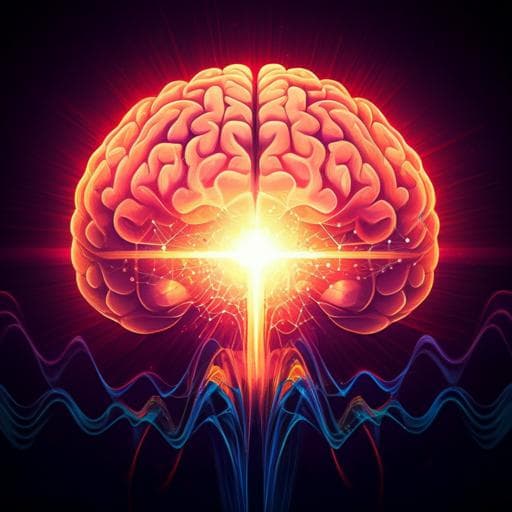
Psychology
Home-based transcranial direct current stimulation treatment for major depressive disorder: a fully remote phase 2 randomized sham-controlled trial
R. D. Woodham, S. Selvaraj, et al.
Discover how a 10-week home-based tDCS treatment significantly alleviated depressive symptoms in 174 participants as evidenced in a randomized trial. Conducted by a team of researchers from the University of East London and McGovern Medical School, the study showcases high efficacy and safety, heralding a new approach to managing Major Depressive Disorder.
~3 min • Beginner • English
Introduction
Major depressive disorder (MDD) is highly prevalent, disabling, and a major risk factor for suicide. It features persistent low mood/anhedonia with disturbances in sleep, appetite, psychomotor activity, energy, and cognition. Although antidepressants and psychological therapies are first-line, over one-third of patients fail to achieve remission. Transcranial direct current stimulation (tDCS), a noninvasive brain stimulation applying weak direct current via scalp electrodes, modulates cortical excitability and network connectivity, particularly when anodal stimulation targets left dorsolateral prefrontal cortex (DLPFC) and cathodal the right DLPFC. Meta-analyses of clinic-based tDCS show efficacy and tolerability versus sham, but traditional protocols require frequent clinic visits. Given the portability and safety of tDCS, home-based use with remote supervision is feasible. Prior home-based RCTs in MDD were limited by in-person visits, small samples, and 6-week durations, showing no significant active–sham differences; recent evidence suggests effects accrue up to 10 weeks. This trial aimed to test the efficacy, acceptability, and safety of a fully remote, 10-week home-based tDCS regimen in adults with MDD of at least moderate severity across the UK and USA, comparing active versus sham stimulation.
Literature Review
The paper reviews neurophysiological mechanisms of tDCS (anodal depolarization increasing excitability; cathodal hyperpolarization decreasing excitability) and network-level effects including modulation of default mode, self-referential, and frontoparietal networks and limbic structures relevant to MDD. An individual participant data meta-analysis reported higher response (30.9% vs 18.9%; NNT=9) and remission (19.9% vs 11.7%; NNT=13) with active versus sham tDCS in clinic-based studies. Prior home-based RCTs in MDD (n=11, n=58, and one larger trial) were not fully remote, likely underpowered and limited to 6 weeks, finding no significant active–sham differences. A meta-analysis by Nikolin et al. indicated tDCS antidepressant effects continue to increase up to 10 weeks. A recent large clinic-based RCT (DepressionDC) found no adjunctive benefit over SSRIs in a 6-week trial, potentially influenced by greater proportions of highly treatment-resistant patients. These data motivated a longer, adequately powered, fully remote trial to detect clinically meaningful differences at 10 weeks.
Methodology
Design: International, multisite, double-blind, randomized, sham-controlled, superiority phase 2 trial of 10-week home-based tDCS for MDD, followed by a 10-week open-label phase. Sites: University of East London (UK) and UTHealth Houston (USA). Ethics: Approvals from South Central-Hampshire B REC (22/SC/0023) and WIRB-Copernicus Group IRB (1324775). Registration: NCT05202119.
Participants: Adults ≥18 years with DSM-5 MDD in a current episode of at least moderate severity (17-item HDRS ≥16), assessed by MINI v7.0.2. Allowed: treatment-free, stable antidepressant medication, and/or psychotherapy ≥6 weeks before enrolment with agreement to maintain during trial; under the care of a GP/psychiatrist. Key exclusions: treatment-resistant depression defined as inadequate response to ≥2 adequate antidepressant trials; high suicide risk (C-SSRS); comorbid psychiatric disorders; medications affecting cortical excitability (e.g., benzodiazepines, antiepileptics); neurological contraindications to tDCS. Sex self-reported; no sex/gender exclusions.
Recruitment and procedures: Online prescreen via Flow Neuroscience, telephone prescreen, written e-consent, baseline assessment via Microsoft Teams. Remote training in device use; initial tDCS session supervised via videoconference. Subsequent sessions self-administered at home with remote monitoring (real-time compliance via app). Safety access via 24-h contact number. Participants compensated per visit; UK participants could keep the device after completion.
Randomization and blinding: 1:1 active vs sham, independently at each country site; block randomization with permuted blocks of 4 and 6 performed by sponsor, allocation concealed from research team and participants. Identical-appearing devices and procedures. Outcome assessors blinded; a second rater present for clinical scales to maintain blinding. At week 10, before unblinding, participants guessed allocation and certainty (1–5 scale).
Intervention: Flow FL-100 headset with two pre-positioned conductive rubber electrodes (23 cm²) approximately over F3 (anode, left DLPFC) and F4 (cathode, right DLPFC) according to 10–20 EEG system. Active tDCS: 2 mA for 30 min, ramp up 120 s, ramp down 15 s. Sham tDCS: mimicked sensations via 0→1 mA ramp up 30 s then down 15 s at start and repeated at end; otherwise 0 mA. Schedule: weeks 1–3 five sessions/week; weeks 4–10 three sessions/week (total 36 sessions). Open-label phase: all participants received active tDCS; prior active-arm participants offered three sessions/week for 10 weeks; prior sham-arm participants received the full active schedule.
Outcomes and assessments: Primary: adjusted mean group difference in HDRS (17-item) change from baseline to week 10. Secondary: MADRS and MADRS-s change; response (≥50% reduction from baseline) and remission (HDRS ≤7; MADRS ≤10; MADRS-s ≤12) at week 10; EQ-5D-3L quality-of-life change. Exploratory: adherence correlations; anxiety (HAM-A) and hypomania/mania (YMRS) at week 10; neuropsychological tests—RAVLT (total learning) and SDMT—at baseline, week 10, and week 20. Safety: adverse events assessed each visit; tDCS Adverse Events Questionnaire at weeks 10 and 20.
Sample size: Based on Brunoni et al., powered for 80% (one-sided α=0.025) requiring n=176; targeted up to 216 to reach 87.6% power, anticipating 20% attrition total n=270. A prespecified interim analysis (after 90 participants completed week 10) enabled futility stopping and sample size re-estimation; recruitment ended early based on a blinded interim assessment.
Statistical analysis: Modified intention-to-treat (mITT) included all randomized participants who received ≥1 session; per-protocol excluded major protocol deviations and insufficient exposure. Primary analysis used a mixed model for repeated measures (MMRM) including baseline HDRS, antidepressant status, psychotherapy, age, sex; unstructured covariance. Missing data handled under direct likelihood; multiple imputation with Fully Conditional Specification was used for certain reported estimates and combined via Rubin’s rules. One-sided α=0.025 for primary. Secondary endpoints tested hierarchically with Hochberg multiplicity control. Group comparisons via t-tests or Fisher’s exact tests; ORs with 95% CIs for categorical outcomes; Spearman correlations for exploratory analyses.
Key Findings
Enrollment and sample: From 17,951 prescreens and 2,234 phone prescreens, 368 were assessed by video; 174 randomized (87 active, 87 sham). mITT n=173 (one sham participant never started). Mean age 37.63±11.00 years; 69% women; mean baseline HDRS 19.07±2.73. Treatment status at baseline: 32.8% treatment-free; 62.6% on antidepressants; 14.9% in psychotherapy; 10.3% both medication and psychotherapy. Discontinuation: 14.3% overall (active 14.9% (13/87) vs sham 13.7% (12/87), P=0.99).
Primary outcome (HDRS): Greater improvement with active tDCS: mean decrease 9.41±6.25 vs 7.14±6.10 in sham; estimated week-10 means 9.58±6.02 (active) vs 11.66±5.96 (sham). Between-group difference 2.26 points (95% CI 0.51–4.01), P=0.012. Difference also significant by week 4 (95% CI 0.2–3.4, P=0.03).
Secondary outcomes:
- HDRS response: 58.3% active vs 37.8% sham; OR 2.31 (1.17–4.55), P=0.017; NNT≈5.
- HDRS remission: 44.9% active vs 21.8% sham; OR 2.93 (1.41–6.09), P=0.004; NNT≈4.
- MADRS change: −11.31±8.81 active vs −7.74±8.47 sham; difference 3.57 (1.06–6.07), P=0.006; Cohen’s d≈0.41. Response: 64.2% vs 32.3%, OR 3.76 (1.83–7.74), P<0.001; Remission: 57.5% vs 29.4%, OR 3.26 (1.53–6.94), P=0.002.
- MADRS-s change: −9.90±8.94 active vs −6.23±9.13 sham; difference 3.66 (0.93–6.40), P=0.009; Cohen’s d≈0.41. Response: 51.8% vs 25.1%, OR 3.22 (1.50–6.94), P=0.002; Remission: 53.8% vs 23.4%, OR 3.83 (1.61–9.13), P=0.002.
- Quality of life (EQ-5D-3L): No significant between-group difference (P=0.326).
Exploratory outcomes: Anxiety (HAM-A) improvement numerically favored active (−6.62±6.09) vs sham (−4.88±5.88), P=0.08 (ns). YMRS at week 10: lower with active (mean 1.27±1.40) vs sham (1.84±1.69), P=0.03; no new-onset mania/hypomania.
Neuropsychology: No significant group differences on RAVLT or SDMT.
Blinding: Before unblinding, 77.6% in active and 59.3% in sham guessed ‘active’; P=0.01. High certainty (ratings 4–5) reported by 57.6% (active guesses) and 41.7% (sham guesses); a notable minority were very uncertain (active 16.7%, sham 18.8%).
Safety and adverse events: No serious device-related adverse events; no mania/hypomania or serious suicide risk events. Anticipated AEs at week 10 higher with active for skin redness (63.5% vs 18.5%, P<0.001), skin irritation (6.9% vs 0%, P=0.03), and trouble concentrating (14.1% vs 3.7%, P=0.03). Two active-arm participants reported transient superficial ‘burns’ at the anode site, likely due to insufficient sponge moistening; no residual lesions or scarring; sessions paused to allow healing. Unanticipated AEs: overall similar across groups; skin/subcutaneous tissue disorders slightly higher with active (19.5% vs 8.1%, P=0.05). Acceptability: discontinuation rates low and similar between arms.
Discussion
This fully remote, multisite RCT demonstrated that a 10-week home-based, remotely supervised tDCS regimen targeting bilateral DLPFC significantly reduced depressive symptoms versus sham across clinician-rated and self-reported measures, with response and remission rates approximately 2–3 times higher than sham. Findings extend clinic-based evidence by showing efficacy, acceptability, and safety in a real-world, at-home setting across a heterogeneous MDD population, including those on stable antidepressants or psychotherapy and those treatment-free. The longer 10-week duration likely contributed to the robust effects, aligning with meta-analytic evidence that tDCS benefits accrue over time. Compared with prior home-use trials limited to 6 weeks and smaller samples, this study’s fully remote design, real-time compliance monitoring, and adequate sample size enabled detection of clinically meaningful effects. Safety was favorable with mostly mild, localized skin events and no serious device-related harms or mood destabilization. Although more participants in the active arm suspected receiving active treatment, certainty was limited and efficacy remained significant, suggesting that observed benefits are unlikely to be explained by expectancy alone. Overall, results support home-based tDCS as a viable, scalable intervention for MDD with rigorous remote oversight.
Conclusion
A 10-week course of home-based, remotely supervised active tDCS produced significantly greater reductions in depressive severity, higher response, and higher remission rates versus sham in adults with MDD of at least moderate severity, with good acceptability and safety. Benefits were observed across patients on stable antidepressants, in psychotherapy, and those treatment-free. These findings support home-based tDCS as a potential first-line or adjunct treatment option for MDD, contingent on continued safety monitoring. Future research should refine personalization (e.g., electric field modeling and montage optimization), examine longer-term maintenance strategies, identify moderators (e.g., treatment resistance level, baseline network markers), and evaluate integration with targeted cognitive interventions or digital therapeutics.
Limitations
- Blinding assessment lacked a ‘don’t know’ option, limiting calculation of blinding indices; more participants in the active arm guessed ‘active’.
- Potential interindividual variability in electric field distribution due to head anatomy and headset positioning, which may influence outcomes despite training and remote observation.
- All clinical ratings were conducted via videoconference; while generally concordant with in-person assessments, this may affect generalizability.
- No significant between-group differences in self-reported quality of life; baseline QoL scores were relatively high, potentially limiting detectable change.
- Sample had limited ethnic diversity and a higher proportion of women, which may limit generalizability.
- Exclusion of individuals with a history of hospitalization for severe episodes and those with highly treatment-resistant depression (≥2 failed adequate trials) may limit applicability to the most severe TRD cases.
Related Publications
Explore these studies to deepen your understanding of the subject.







